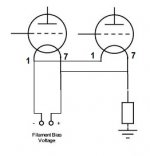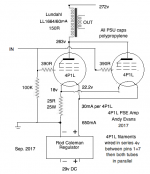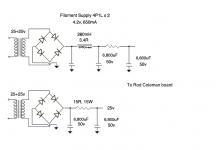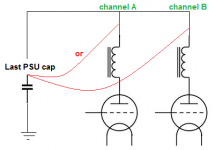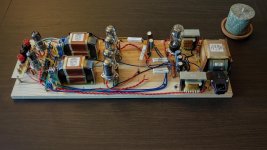Filament bias resistors....
- something porcelain or vitreous enamel, like Welwyn WW series
- russian resistors like this, various values
2.2 kOhm 10W Russian Precision Wire Wound Resistors 18 pcs | eBay
I've used these in filament bias, and several other positions, crossovers, etc. They are quite good, especially for the price.
Just copy the diagram.
I will! Just trying to understand. Thanks.
What am I missing?
Yes, it's practically a voltage divider ... in terms of filament power supply.
The filament power supply output voltage must be equal the bias voltage (on the resistor) + filament voltage of tube.
The point of filament bias is to put all the filament current through the resistor, so you end up with a small value resistor (but high wattage) which doesn't need a cathode bypass cap. Bear in mind that since the filament supply is going through the cathode resistor as well as the signal, the filament supply has to be as pure as possible. Rod Coleman's regs are absolutely what you want here. I go further and use a choke input supply to the regs. The filament supply voltage as stated is the bias voltage plus the filament voltage plus headroom for the regulator to work, anything from 5-7v typically but Rod will advise and give you all the right parts. So yes, you have a very unconventional filament supply of nearly 30v for a tube with a filament voltage of 4.2v. That's how it all works - Thomas Mayer of Vinylsavor made the idea popular and with the right tube it's great. 4P1L works particularly well since the bias voltage is relatively small. A high bias voltage starts making things difficult (and hot), so not really what you could use for a 2a3 or 300b.
Frankly I'm not fussy about what kind of filament transformer. I generally use CLC and play around with the first capacitor to get the right output voltage. You can go from no first cap (choke input) to a large cap like 4,700uF which gives you cap input, but I play around with first cap values of e.g. 100, 270, 470uf which gives you a rising output voltage. The main cap is usually 6,800 or 10,000uF, whatever I have. You can also use a resistor to drop the voltage, but it tends to get hot. The filament supply needs a lot of juggling with values and it can take a while to get it just right. Two separate supplies needed. I put them both in a large ABS box and use a 4 pole XLR for a connector. Very useful. I attach an old diagram I made of a filament supply - can't remember what it was exactly since it was a while ago but it would be in the ballpark. You'd need to check the values.
Attachments
What are you guys using - toroids?
IMHO -general- toroid is not the best choice.
Usually the primary-secondary capacitance is very high (nF magnitude) against for example standard EI transformer (even below 100pF), so noise from line gets through easily.
The best choice is the two bobbin transformer (secondary and primaries are separated) with enough low primary-secondary capacitance.
I have done my first tube amp! And it's working! And it feels great!
Some pictures of your amp?
- Status
- This old topic is closed. If you want to reopen this topic, contact a moderator using the "Report Post" button.
- Home
- Amplifiers
- Tubes / Valves
- Yet another 4P1L PSE amp - review request
